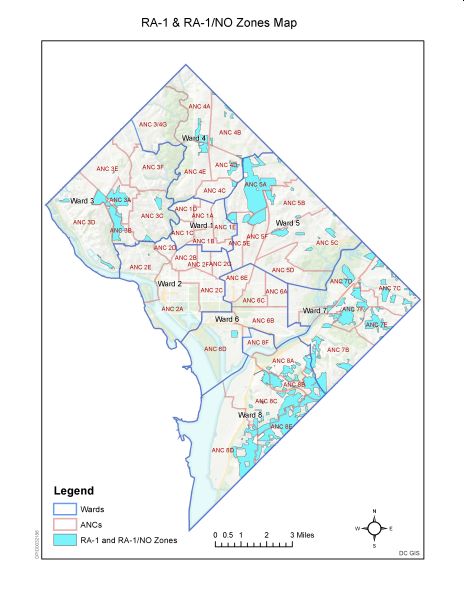- within Criminal Law topic(s)
- in North America
The D.C. Office of Planning (OP) on June 2, 2025, submitted a set down report recommending that the Zoning Commission hold a public hearing on a proposed text amendment that would update the Zoning Regulations for the Residential Apartment (RA-1) zone. The text amendment is intended to clarify existing standards, simplify review processes, address community concerns and support the goals of the Comprehensive Plan.
What Is the RA-1 Zone?
The RA-1 zone allows low- to moderate-density residential development such as detached houses, rowhouses and low-rise apartment buildings. Unlike most other zones, the RA-1 zone requires special exception approval from the Board of Zoning Adjustment (BZA) for almost all new residential development. This requirement was added in 1970 to help manage growth and ensure compatibility of development with surrounding neighborhoods. Currently, only single-family detached and semi-detached homes are allowed as a matter-of-right in the RA-1 zone.
Where Is the RA-1 Zone Located?
As shown on the map below, the RA-1 zone exists throughout much of the District. Wards 1, 2 and 6 have the least amount of RA-1 zoning, whereas Wards 3, 4, 5, 7 and 8 have larger, more contiguous areas of RA-1 zoning.

Source: D.C. Office of Planning
Why Update the RA-1 Zone?
The RA-1 text amendment was requested by the D.C. Zoning Commission and BZA, as well as in response to issues raised by Advisory Neighborhood Commissions (ANCs) and District residents. The goals of the amendment are to:
- analyze the current intent, review standards and development patterns of the RA-1 zone
- ensure that the Zoning Regulations advance the purpose and intent of the RA-1 zone
- provide greater clarity in the Zoning Regulations
- refine new development review standards
- continue to promote flexibility for new, diverse development that is compatible with existing development patterns
- allow reasonable expansions of existing residential buildings as a matter-of-right
- allow new rowhouses as a matter-of-right
- identify ANC and community concerns related to new residential development in RA-1
The proposed text amendment does not propose rezoning any properties to or from RA-1.
Key Proposed Changes
The proposed text amendment includes several meaningful changes:
- Matter-of-Right Development. Detached and semi-detached dwellings, either single-family or flat (two families), would continue to be allowed by-right. A rowhouse, currently allowed only by special exception, would be allowed by-right. New provisions would allow an apartment house of up to four units as a matter-of-right and would allow by-right renovations to existing apartment houses to allow for the enlargement of existing units or the conversion of underutilized space into new units.
- New Residential Development. Proposed modifications would retain the existing special exception review requirement for apartment houses of more than four units and those seeking lot dimension flexibility.
- Side Yard Requirements. Apartment houses with more than four units would need to provide two side yards with greater minimum widths to better protect privacy and access to light.
- Voluntary Inclusionary Zoning (IZ). Developers would be able to opt into the IZ program by-right without needing BZA approval to encourage affordable housing.
- Special Exception Review. Apartment houses with more than four units or those needing flexibility in lot dimensions would still go through the BZA process but with clarified review criteria and opportunities for public input.
- Streamlined Filing Requirements. Projects requiring BZA relief would be required to submit detailed materials with the initial application, thus improving transparency and review efficiency (e.g., site and architectural plans, streetscape and alley-scape photos, or shadow studies).
How Does This Support the Comprehensive Plan?
The proposed text amendment advances key Comprehensive Plan objectives in the following areas:
- Land Use – supports infill development and maintains neighborhood character
- Housing – encourages affordable, well-designed housing options
- Urban Design – promotes development that complements the visual context of surrounding areas
- Historic Preservation – balances the need for new housing with respect for historic neighborhoods
The proposed text amendment was reviewed through a racial equity lens to help ensure equitable access to housing and neighborhood opportunities across the District.
Community Engagement
OP has conducted extensive outreach, including hosting virtual meetings with ANC commissioners and maintaining a dedicated project webpage. So far, feedback has been generally positive, especially around the move to allow more by-right development and simplify the review process. OP continues to welcome community feedback as the proposal moves forward.
What This Means for the Development Community
If adopted, these updates could benefit the development community by:
- enabling a broader mix of housing types with fewer procedural steps
- supporting expansion and conversion of existing buildings into new residential units
- allowing by-right participation in the IZ program
- clarifying and streamlining the path to BZA approval for larger projects
Next Steps
The OP presented the proposed text amendment to the Zoning Commission at its public meeting on June 12, 2025. At that meeting, the Commission voted to set down the application for a public hearing, which will be scheduled for a future date and provide an opportunity for additional public feedback before a final vote. Developers, residents and other stakeholders are encouraged to attend and participate.
Why It Matters
This update to the RA-1 zone represents an important step in addressing D.C.'s housing needs while maintaining neighborhood integrity. By making the development process more predictable and flexible, the proposed changes aim to support inclusive, high-quality growth across the city.
The content of this article is intended to provide a general guide to the subject matter. Specialist advice should be sought about your specific circumstances.


